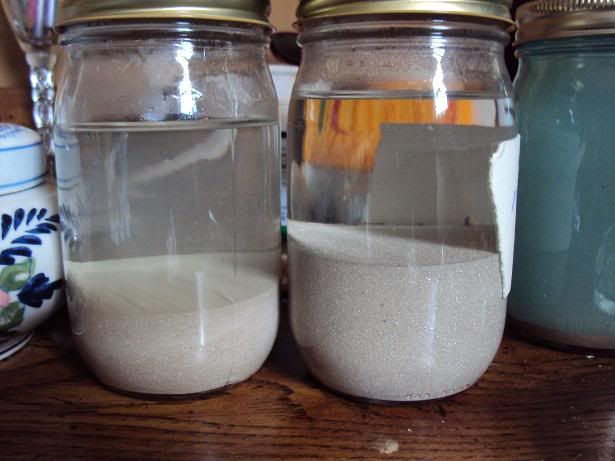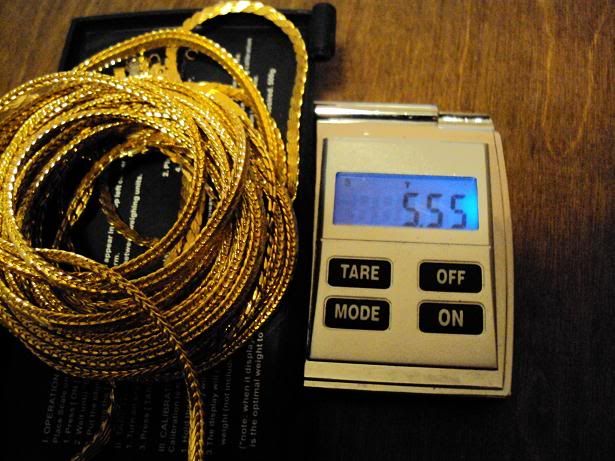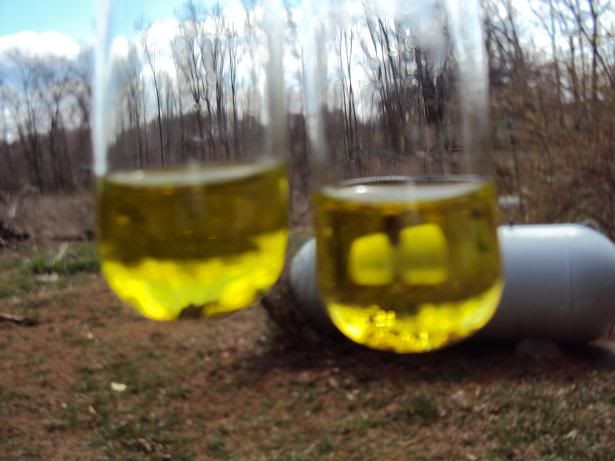Hello
I finally got my book so I hope I'm not asking stupid questions .
Thanks to everyones help the cementing silver is going great . I'm at a point where I need to break from silver and deal with clean up of things getting to much stuff setting around that needs properly disposed of . Waiting on some solder so I can make a testing solution so untill I get it thats on hold .

If I did this right this is silver I cemented out so far . The reason for two jars is some of the contacts were slightly magnetic so I kept them seperated .
Reading Hokes book I'm learning plenty and trying to put a few things she mentions into use so I'm doing some test . My test aren't trying to re-invent the wheel they are geared towards finding the right process to proceed with .

I have quite a bit of gold to play with and thought I'd start with the lesser quality stuff first . That would be 5 .55 troy ounce of this chain I thought was gold filed . Recient test seem to indacate it's a better material than I first thought .
I took two 0.5 gram samples and applied red heat to one trying to melt it and couln't with the little map gas torch . Looking with a loup I could see that the gold kinda pooled in spots leaving a grey/black material exposed .
I placed both 0.5 samples into a test tube and covered with just a little AR .

The sample I roasted turned yellow green fast in AR . The grey/black material was gone fast leaving only a few nugets of gold colored material . Thats the tube on the left . In about 5 more minutes the roasted sample had turned yellowish just like the other sample . To this point no heat has been applied it was done outside and it's 33 degrees today .
I think the green I seen at first is nickle simply because I couldn't melt it into a bead and the chain is slightly magnetic . I do think they is silver in the mix as I seen a grey material in the bottom of the tube that Hoke explains is most likley AgCl from the reaction with the acid .
This leave me wondering if I wouldn't be best to roast the material and then use the acid Hoke mentions to remove metal fragments in jewelers scrap . Just reading it once I'll have to refer back to it and make certain the type but I'm thinking she said sulfuric to remove metal prior to proceeding with AR .
This leaves me a question .
1 ) If I did use that process can I recover any silver later ? The AR seems to be working good but with the expence of good nitric I'd prefer using an acid I can get for free to do half the work then proceed with AR .
2 ) I have some old storm precipitant . Will this be ok for droping gold or should I buy some fresh ? Yea I'll buy the pure chemical not shores storm stuff I just can't remember the name of it off the top of my head . I couldn't spell it if I could but it's the same stuff anyhow .
3 ) Hoke advises to start with about a 50 penny weight batch and expand as you learn what your doing . Does this sound about right for a new guys first time doing this ?
I hope I haven't asked any stupid questions . Thanks for any help or advise doing this .
Lonnie
I finally got my book so I hope I'm not asking stupid questions .
Thanks to everyones help the cementing silver is going great . I'm at a point where I need to break from silver and deal with clean up of things getting to much stuff setting around that needs properly disposed of . Waiting on some solder so I can make a testing solution so untill I get it thats on hold .

If I did this right this is silver I cemented out so far . The reason for two jars is some of the contacts were slightly magnetic so I kept them seperated .
Reading Hokes book I'm learning plenty and trying to put a few things she mentions into use so I'm doing some test . My test aren't trying to re-invent the wheel they are geared towards finding the right process to proceed with .

I have quite a bit of gold to play with and thought I'd start with the lesser quality stuff first . That would be 5 .55 troy ounce of this chain I thought was gold filed . Recient test seem to indacate it's a better material than I first thought .
I took two 0.5 gram samples and applied red heat to one trying to melt it and couln't with the little map gas torch . Looking with a loup I could see that the gold kinda pooled in spots leaving a grey/black material exposed .
I placed both 0.5 samples into a test tube and covered with just a little AR .

The sample I roasted turned yellow green fast in AR . The grey/black material was gone fast leaving only a few nugets of gold colored material . Thats the tube on the left . In about 5 more minutes the roasted sample had turned yellowish just like the other sample . To this point no heat has been applied it was done outside and it's 33 degrees today .
I think the green I seen at first is nickle simply because I couldn't melt it into a bead and the chain is slightly magnetic . I do think they is silver in the mix as I seen a grey material in the bottom of the tube that Hoke explains is most likley AgCl from the reaction with the acid .
This leave me wondering if I wouldn't be best to roast the material and then use the acid Hoke mentions to remove metal fragments in jewelers scrap . Just reading it once I'll have to refer back to it and make certain the type but I'm thinking she said sulfuric to remove metal prior to proceeding with AR .
This leaves me a question .
1 ) If I did use that process can I recover any silver later ? The AR seems to be working good but with the expence of good nitric I'd prefer using an acid I can get for free to do half the work then proceed with AR .
2 ) I have some old storm precipitant . Will this be ok for droping gold or should I buy some fresh ? Yea I'll buy the pure chemical not shores storm stuff I just can't remember the name of it off the top of my head . I couldn't spell it if I could but it's the same stuff anyhow .
3 ) Hoke advises to start with about a 50 penny weight batch and expand as you learn what your doing . Does this sound about right for a new guys first time doing this ?
I hope I haven't asked any stupid questions . Thanks for any help or advise doing this .
Lonnie










































































